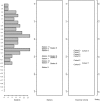Developing a video-based method to compare and adjust examiner effects in fully nested OSCEs
- PMID: 30575092
- PMCID: PMC6519246
- DOI: 10.1111/medu.13783
Developing a video-based method to compare and adjust examiner effects in fully nested OSCEs
Abstract
Background: Although averaging across multiple examiners' judgements reduces unwanted overall score variability in objective structured clinical examinations (OSCE), designs involving several parallel circuits of the OSCE require that different examiner cohorts collectively judge performances to the same standard in order to avoid bias. Prior research suggests the potential for important examiner-cohort effects in distributed or national examinations that could compromise fairness or patient safety, but despite their importance, these effects are rarely investigated because fully nested assessment designs make them very difficult to study. We describe initial use of a new method to measure and adjust for examiner-cohort effects on students' scores.
Methods: We developed video-based examiner score comparison and adjustment (VESCA): volunteer students were filmed 'live' on 10 out of 12 OSCE stations. Following the examination, examiners additionally scored station-specific common-comparator videos, producing partial crossing between examiner cohorts. Many-facet Rasch modelling and linear mixed modelling were used to estimate and adjust for examiner-cohort effects on students' scores.
Results: After accounting for students' ability, examiner cohorts differed substantially in their stringency or leniency (maximal global score difference of 0.47 out of 7.0 [Cohen's d = 0.96]; maximal total percentage score difference of 5.7% [Cohen's d = 1.06] for the same student ability by different examiner cohorts). Corresponding adjustment of students' global and total percentage scores altered the theoretical classification of 6.0% of students for both measures (either pass to fail or fail to pass), whereas 8.6-9.5% students' scores were altered by at least 0.5 standard deviations of student ability.
Conclusions: Despite typical reliability, the examiner cohort that students encountered had a potentially important influence on their score, emphasising the need for adequate sampling and examiner training. Development and validation of VESCA may offer a means to measure and adjust for potential systematic differences in scoring patterns that could exist between locations in distributed or national OSCE examinations, thereby ensuring equivalence and fairness.
Keywords: OSCEs; assessment; assessor variability; psychometrics.
© 2018 The Authors. Medical Education published by Association for the Study of Medical Education and John Wiley & Sons Ltd.
Conflict of interest statement
none declared.
Figures




References
-
- Watling CJ. Unfulfilled promise, untapped potential: feedback at the crossroads. Med Teach 2014;36:692–7. - PubMed
-
- Wass V, van der Vleuten CPM, Shatzer J, Jones R. Assessment of clinical competence. Lancet 2001;357 (9260):945–9. - PubMed
-
- Schuwirth LWT, van der Vleuten CPM. Programmatic assessment: from assessment of learning to assessment for learning. Med Teach 2011;33 (6):478–85. - PubMed
-
- Ten Cate O. Entrustability of professional activities and competency‐based training. Med Educ 2005;39 (12):1176–7. - PubMed
-
- Ginsburg S, van der Vleuten CPM, Eva KW, Lingard L. Cracking the code: residents’ interpretations of written assessment comments. Med Educ 2017;51 (4):401–10. - PubMed

